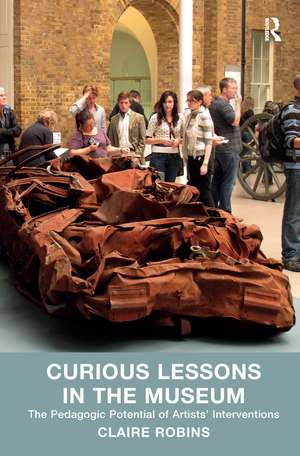Curious Lessons in the Museum: The Pedagogic Potential of Artists' Interventions
Autor Claire Robinsen Limba Engleză Hardback – 26 aug 2013
Preț: 795.03 lei
Preț vechi: 1104.56 lei
-28% Nou
Puncte Express: 1193
Preț estimativ în valută:
152.13€ • 165.77$ • 128.19£
152.13€ • 165.77$ • 128.19£
Comandă specială
Livrare economică 03-17 aprilie
Doresc să fiu notificat când acest titlu va fi disponibil:
Se trimite...
Preluare comenzi: 021 569.72.76
Specificații
ISBN-13: 9781409436171
ISBN-10: 1409436179
Pagini: 260
Dimensiuni: 156 x 234 x 22 mm
Greutate: 0.62 kg
Ediția:New.
Editura: Taylor & Francis
Colecția Routledge
Locul publicării:Oxford, United Kingdom
ISBN-10: 1409436179
Pagini: 260
Dimensiuni: 156 x 234 x 22 mm
Greutate: 0.62 kg
Ediția:New.
Editura: Taylor & Francis
Colecția Routledge
Locul publicării:Oxford, United Kingdom
Recenzii
’In this engaging and thought-provoking work, the author enlivens the recent history of pedagogically motivated artists’ interventions and offers significant insights into the curious lessons they provide to museum and gallery learning departments.’ Julie Sheldon, Liverpool John Moores University, UK
’With deft scholarly touch, Robins traces the pedagogic thread of artists' interventions woven throughout the history of museum collections both private and public, from the historical to the contemporary. In so doing, she reveals the subtle and witty complexity and broad educational agency of these interventions, making the book essential reading for museum scholars, students and professionals today.’ Helen Charman, Design Museum London, UK
’In this historical overview of museum pedagogy, Claire Robins points out that many recent artistic interventions seek to tap the pre-Enlightenment wonder of the institution. She analyzes compelling instances from Andy Warhol to Fred Wilson and Jeremy Deller, as well as her own performance at the William Morris Gallery, England. She argues for artists’ interventions as an increasingly more accurate term than the fashionable institutional critique, for the wide-ranging, ever growing roster of contemporary artist/ trickster legitimated transgressions embraced by museums to freshen their image. Highly recommended for all parties in this complex interplay.’ Lewis Kachur, Kean University, USA and author of Displaying the Marvelous: Marcel Duchamp, Salvador Dali and Surrealist Exhibition Installations
’... the content is well-researched, insightful and page-turning, and this work has the potential to stimulate further research and constructive dialogue in the field. This publication is appropriate for students and professionals of museum studies, while at the same time art historians, and even artists, would find the content of this book equally fascinating.’ Rosetta
'The strength of the book lies in the author's commitment to represent a wide and disparate set of voices, among them contemporary artists, social and museological theorists, and arts educators. This approach will no doubt provide new insights to any reader, as few authors have attempted to combine these competing concerns in existing scholarship.' Art Journal
’With deft scholarly touch, Robins traces the pedagogic thread of artists' interventions woven throughout the history of museum collections both private and public, from the historical to the contemporary. In so doing, she reveals the subtle and witty complexity and broad educational agency of these interventions, making the book essential reading for museum scholars, students and professionals today.’ Helen Charman, Design Museum London, UK
’In this historical overview of museum pedagogy, Claire Robins points out that many recent artistic interventions seek to tap the pre-Enlightenment wonder of the institution. She analyzes compelling instances from Andy Warhol to Fred Wilson and Jeremy Deller, as well as her own performance at the William Morris Gallery, England. She argues for artists’ interventions as an increasingly more accurate term than the fashionable institutional critique, for the wide-ranging, ever growing roster of contemporary artist/ trickster legitimated transgressions embraced by museums to freshen their image. Highly recommended for all parties in this complex interplay.’ Lewis Kachur, Kean University, USA and author of Displaying the Marvelous: Marcel Duchamp, Salvador Dali and Surrealist Exhibition Installations
’... the content is well-researched, insightful and page-turning, and this work has the potential to stimulate further research and constructive dialogue in the field. This publication is appropriate for students and professionals of museum studies, while at the same time art historians, and even artists, would find the content of this book equally fascinating.’ Rosetta
'The strength of the book lies in the author's commitment to represent a wide and disparate set of voices, among them contemporary artists, social and museological theorists, and arts educators. This approach will no doubt provide new insights to any reader, as few authors have attempted to combine these competing concerns in existing scholarship.' Art Journal
Notă biografică
Claire Robins is a senior lecturer in Art, Design and Museology at the UCL Institute of Education, University College London,UK.
Cuprins
Introduction; Part I Artists, Museums and Education in Historical Context; Chapter 1 Shifting priorities for learning in the museum; Chapter 2; Chapter 3 Historical tracings of artists’ interventions in the mid-twentieth century; Part II Parody and Irony in the Museum; Chapter 4 Humour, irony and parody in artists’ interventions; Chapter 5 Jokers, tricksters and the parafictional; Chapter 6 An Elite Experience for Everyone: a case study intervention at the William Morris Gallery, London; Part III Contemporary Museums and the Role of Artists’ Interventions; Chapter 7 The role of artists’ interventions in opening up micro, counter and affective narratives in museum interpretation; Chapter 8 Artists’ interventions and the reflexive museum: addressing difference; Chapter 9 The affable interventionists;
Descriere
Amongst recent contemporary art and museological publications, there have been relatively few which direct attention to the distinct contributions that twentieth and twenty-first century artists have made to gallery and museum interpretation practices. There are fewer still that recognise the pedagogic potential of interventionist artworks in galleries and museums. This book fills that gap and demonstrates how artists have been making curious but, none-the-less, useful contributions to museum education and curation for some time. This valuable book will be essential reading for students and scholars of museum studies, as well as art and cultural studies.
